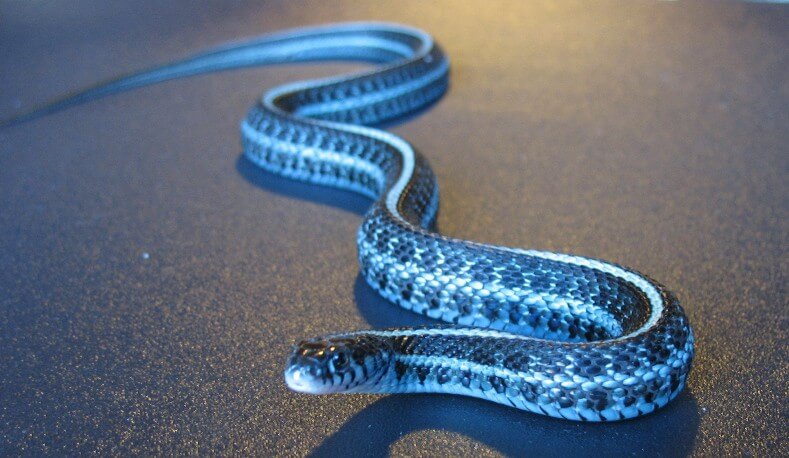10 real snakes in nature that look fantastic

Beauty always attracts people. Many people say that it is a terrible force, and this is especially true if we are talking about snakes.
These reptiles terrify people just by looking at them, but you can't help but agree that many of them are very beautiful.
This article lists ten snakes that look fantastic.
1. Ahaetulla prasina

This snake is one of the most unusual in the world. The body of such a reptile resembles a tropical vine that winds around a tree. It is very long and thin. The color of the scales is bright green.
Grass-green wattles prefer to live in trees; they feel insecure on the ground. The pupils of such a snake are horizontal, and the muzzle is narrow and pointed.
2. Dominican Mountain Boa

Such snakes look pretty slender, but they can be enormous.
The Dominican Mountain Boa tends to avoid meeting people. In moments of aggression, these reptiles spray out a liquid that has a very unpleasant smell. However, no cases of a red boa constrictor attacking a human have been recorded yet.
Usually, such snakes do best in moist forests. Their lifestyle is measured and calm. The color of a Dominican Mountain Boa can be very unusual: a white background, a redhead, and the same bright spots all over the body.
3. Tiger Python

Like all pythons, tiger pythons are distinguished by a sedentary lifestyle and a calm character.
These are giant reptiles; they reach from 1.5 to 4 meters in length. Female tiger pythons are usually smaller than males.
The shades of these reptiles are pretty diverse. The background is usually light, yellow-brown, and large brown or white spots of various sizes and shapes are scattered.
These reptiles are often used during photo shoots and kept in terrariums. Young snakes are timid and nervous. For them, you need to provide for the presence of special shelters. When the snake grows, it will get used to people and no longer be constantly hiding.
4. Green tree python

Such a snake represents nobility and calmness. It has stunning "lime" color scales.
Green pythons are pretty small (if you compare them with all pythons): the most prominent individuals reach 1.5 meters in length. The reptiles' spine protrudes quite strongly, so they can look skinny. However, this is only a distinctive feature, not a pathology.
Paradoxically, green pythons are not only green. Among the representatives of this breed, there are albinos, as well as black and emerald individuals.
5. Milk snake

This reptile is also called the "Cross-striped King Snake". It may seem that the Milk snake is venomous because its color looks like a "warning": the combination of white, bright red and black colors immediately catches the eye. However, it is safe for humans; You can even hold it in your hands.
Such reptiles are often kept in terrariums. In the wild, these snakes spend much time in the water, usually lead a nocturnal lifestyle, and prefer to hide from danger rather than seek adventure.
They eat giant insects, amphibians, birds, lizards, and small rodents.
6. Blue Racer

The name of this snake is fully explained by the significant speed of movement and beautiful scales of bright blue color.
Unfortunately, the blue racer is close to extinction.
These reptiles are safe for humans, but they try to avoid them (and rightly so). If there is a threat, such a snake can begin to react to it quite aggressively.
7. California red-sided garter snake

This snake is also called a "garter". The color of such snakes is unusual and very diverse. These are multi-colored stripes located along the body of the reptile.
Garter snakes usually prefer to live near people's homes: I am glad they are not poisonous.
However, such snakes can effectively defend themselves in case of danger. They emit a very unpleasant-smelling liquid from the cloaca. These reptiles are kept at home by both experienced and novice snake breeders.
8. Narrow-headed mamba

Narrow-headed mamba is a magnificent reptile from Africa. It is dangerous for people, but it is simply impossible not to admire its grace and aesthetics.
The color of the scales of the narrow-headed mamba is very bright, emerald. Some snakes reach a length of 2.5 m.
These reptiles have large dark eyes, a graceful narrow head, and smooth scales. Such snakes are usually active during the day, and at night they rest in some cool forests.
They often wait for their prey, but they can also pursue the victim. These reptiles have small hunting grounds and feed mainly on them.
9. Horned Viper

This snake is considered one of the most dangerous in the world. Because of the small horns sticking out above the head, such a viper looks very threatening. It seems like some dragon.
Its venom is very toxic and quickly takes a person's life. However, this does not prevent some extreme athletes from keeping a horned viper at home.
The snake lives on the Arabian Peninsula in North Africa. Horned viper feels great on dunes in hot deserts.
It usually hunts at night, burying itself in the sand and waiting for its prey. If the snake is in danger, it scares its opponent: it starts rubbing its scales against each other, and as a result, a particular sound is heard.
10. Rainbow Boa Constrictor

The scales of this snake are "metallic"; it sparkles with rainbow colors. Rainbow Boa Constrictor looks especially impressive when the reptile is moving or in the sun. The stronger it shines, the brighter the rainbow boa's scales sparkle.
This snake is not poisonous; moreover-it can even be called peaceful. Such a reptile is often kept at home.
Rainbow boa constrictors are safe for humans, but they are predators. Such snakes usually eat not very large birds and rodents, and young individuals should be given newborn mice.





